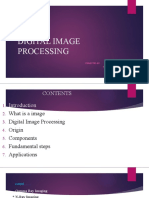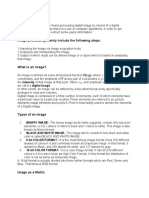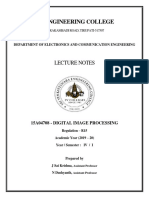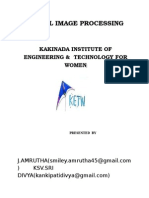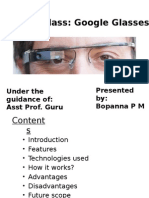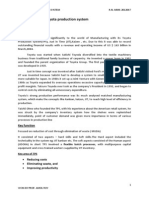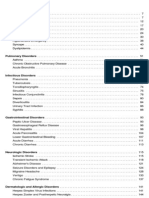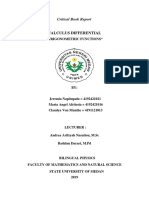DIGITAL IMAGE PROCESSING AND ITS IMPLEMENTATION
USING MAT LAB
SIR CRR COLLEGE OF ENGINEERING
M.Hanumantha Rao
III/IV ECE
E-mail: honeyrao123@gmail.com
Contact No: 9441518887
G.Manikanta
III/IV ECE
Email: gunda.manikanta007@ gmail.com
Contact No: 8985898030
applications etc., In this paper we are focusing the
ABSTRACT
Digital image processing is rapidly evolving field
with
growing
applications
in
science
and
engineering. Image processing holds the possibility
of developing the ultimate machine that could
perform the visual functions as all living beings .
The process of receiving and analyzing visual
information by digital computer is called DIGITAL
IMAGE PROCESSING .This led to evolution of a
new subject called ARTIFICIAL INTELLIGENCE.
We find
applications of these image processing
techniques such as robo vision , biomedical
analysis, criminology, astronomy and space
basics of image processing systems, terminology
associated , various techniques involved in the
image
processing
implementation
and
through
their
effective
MATLAB
software.
MATLAB serves as an excellent platform for the
implementation of image processing. Hence we
explained this by considering some of the
techniques
IMAGE
like
IMAGE
SEGEMENTATION,
ENHANCEMENT
etc.,
through
MATLAB. We conclude the paper by explaining
various applications of image processing. The
advances in technology have created tremendous
opportunities
for
visual
system
and
image
�processing. There is no doubt that the trend will
coordinate value is called SAMPLING. Digitizing
continue into the future.
amplitude values is called QUANTIZATION .an
digital image function is of the form
INTRODUCTION
F(x,y)=
An image may be defined as a two dimensional
function F(x,y) where x,y are spacial coordinates
and the amplitude of F at any pair of coordinates
(x,y) is called the intensity or gray level of the
f(0,0)
f(0,1)..
f(0,n-1)
f(1,0)
f(1,1) ............f(1,n-1)
image at that point .When (x,y) and all amplitude
values of F are all finite discrete quantities we call
the image a DIGITAL IMAGE .Digital Image
Processing pertains to the alteration and analysis of
f(m-1,0)
f(m-1,1)..f(m-1,n-1)
pictorial information of digital image by means of
digital computer.
Each element is called PIXEL OR PELS.
The entire process of image processing and analysis
starting from the receiving of visual information to
Different stages of image processing and
the giving out of the description of the image may
analysis scheme is as shown
be divided into three major stages such as
COMPONENTS
1.) Discretization and representation :converting
visual information into a discrete form :suitable for
computer
processing
,approximating
visual
information to save storage space as well as time
requirement in subsequent processing.
2.)Processing :improving image quality by filtering
etc., compressing data to save storage and channel
capacity during transmission
3.)Analysis: extracting image features; quantifying
shapes ,registration and recognition.
DIGITALIMAGE REPRESENTATION:
An image may be continuous with respect to x and
y coordinates & also in amplitude .Converting such
an image to digital form requires coordinates as
well as amplitude to be digitized. Digitizing the
OF
IMAGE
PROCESSING SYSTEM:
Image sensing
, digitizing ,processing and
displaying are four principal operations
1.)IMAGE SENSOR :An image sensor intercepts
the radiant energy propogating from the scene and
transforms it to produce an intensity image .The
devises used as image sensors range from still
camera to multi spectral scanner on board in
satellites .Television cameras are widely used and
are easy to operate .There are as many as five
different systems used in television imaging.:
IMAGE
ORTHICON
TUBE,ICONOSCOPE
TUBE,
VIDICON
TUBE,IMAGE
DISSECTOR TUBE and CHARGE COUPLED
DEVICES( known as CCD cameras).Apart from
�these optical image sensors image can also be
A display device produces and shows a visual form
captured in devices like X RAY scanner, RADAR ,
of numerical values stored in a computer as a image
ULTRASINIC
array. Principal display devices. are printer, tv
RANGER,
MAGNETIC
RESINANCE IMAGING( MRI) SYSTEM etc.,
monitor, CRTs. .One major problem is,it must
2.)DIGITIZER: A digitizer is required input
refresh the screen at a rate of about 25 frames/sec to
images to a digital computer, produces digital image
avoid
composed of discrete intensity values at discrete
computers are unable to transfer the data at such a
positions .Most of the image sensors have built in
high speed the entire image is kept in a memory
digitizers or provide signal that can be digitized by
commonly called FRAME BUFFER .This memory
straight way by an A/D converter. Micro density
is scanned and displayed at the video rate by direct
meter and flying spot scanner are widely used for
memory access unit which is a special hardware
digitizing photograph.
independent of central processor.
3.)PROCESSOR: Systems
used in image processing .Dedicating image
processing systems connected to host computers are
popular
nowadays
.special
coprocessor
card(with hardware implemented image processing
operators ) and parallel operators are also being
included in many small systems to gain speed
.Interactive graphic devices are also added to
provide image editing facilities .most of the image
processing hard wares
are based on one of the
following architectural concepts:
1.)SERIAL OR VON NEUMANN
ARCHITECTURE
2.)MULTIPLE INSTRUCTION MULTIPLEDEVICE PROCESSORS.
3.)PIPELINES
4.)SINGLE INSTRUCTION MULTIPLE
DEVICE(SIMD) PARALLEL PROCESSORS
many
general
purpose
A GENERAL PURPOSE IMAGE
PROCESSING SYSTEM:
THE VARIOUS IMAGE PROCESSING
TECHNIQUES ARE
1.) Image representation and modeling
2.) Image enhancement
3.) Image restoration
4.) Image analysis
5.) Image reconstruction
6.) Image data compression
IMAGE
REPRESENTATION
AND
MODELLING:
In image representation one is concerned with
characterization of the quantity that each picture
element(pixel )represents .An image could represent
luminance of objects in a scene ,the absorption of
the body tissue(x-ray imaging),radar imaging etc.,
An important consideration in image representation
in the fidelity
DISPLAY UNIT:
.Since
ranging from micro
computers to general purpose large computers are
very
flicker
or the intelligibility criteria for
measuring the quality of an image or the
performance
of
processing
technique.
�Specification of such measures requires models of
or minimization of known degradations in an
perception of contrast , spatial frequencies ,color
image .this includes deblurring of images degraded
and so on .Image quantization is the analog to
by the limitations of a sensor or its environment,
digital conversion of a sampled image to a finite
noise
number of gray levels . A classical method of signal
distortions or non linearities due to sensors. The
representation is by an orthogonal series expansion
image of a point source is blurred and degraded due
such as fourier series .For images, analog
to noise by an imaging system. If the imaging
representation is possible via two dimensional
system is linear the image of an object can be
orthogonal functions called BASIS IMAGES .For
expressed as
sampled images basis images can be determined
from
unitary
matrices
called
filtering
and
correction
of
geometry
G(x,y)=h(x,y;,)f(,)d d+ (x,y)
IMAGE
TRANSFORMS.
The three canonical forms of a STOCHASTIC
MODELS
IMAGE ENHANCEMENT:
In image enhancement , the goal is to accentuate
certain image features for subsequent analysis or for
image display .Examples include contrast and edge
enhancement, pseudo coloring, noise filtering,
sharpening and magnifying .Image enhancement is
useful in feature extraction , image analysis and
visual
information display. The
enhancement
techniques such as contrast stretching, map each
gray
level
into
another
gray
level
by
predetermined transformation.
IMAGE RESTORATION: It refers to the removal
Where (x,y) is the additive noise function, f(,) is
the object ,g(x,y) is the image and h(x,y;,) is
called the point spread function(psf).A typical
image restoration problem is to find an estimate of
f(,) given the PSF , the blurred image and the
statistical properties of the noise process
�angles. Reconstruction algorithms derive an image
of a thin axial slice of the object giving an inside
view otherwise unobtainable with out performing
extensive surgery. Such techniques are important in
medical imaging (CT scanners),astronomy ,radar
imaging and non destructive testing of assemblies.
IMAGE DATA COMPRESSION:
IMAGE ANALYSIS:
Image
analysis
is
concerned
with
making
quantitative measurements from an image to
produce a description of it. In the simplest form,
this task could be reading a label on a grocery item ,
sorting different parts on an assembly line or
measuring the size and orientation of blood cells in
a medical image. More advanced image analysis
systems measure quantitative information and use it
to make a sophisticated decision,such as controlling
the arm of a robot to move an object after
identifying it or navigating an aircraft with the aid
images acquired along its trajectory.Image analysis
techniques require extraction of certain features that
aid in the identification of the object.Segmentation
techniques are used to isolate the desired object
from the scene so that measurements can be made
on it subsequently.
IMAGE
RECONSTRUCTION
FROM
PROJECTIONS :
Image reconstructions from projections is a special
The amount of data associated with visual
information is so large that its storage would require
enormous storage capacity .Although the capacities
of several storage media are substantial, their access
speeds are usually inversely proportional to their
capacity .Typical television images generate data
rates exceeding 10 million bytes per sec. There are
other image sources that generate higher data rates
storage and/or transmission of such data require
large capacity and/or band width which could be
very expensive. Image data compression techniques
are concerned with reduction of the no of bits
required to store or transmit he images without any
appreciable loss of information. Because of wide
applications
like
teleconferencing
computer
remote
communications,
sensing
etc.,
data
compression is of great importance in digital image
processing.
IMPLEMENTATION
THROUGH
MAT
class of image restoration problems where a two
LAB :
dimensional object is reconstructed from several
MATLAB
one dimensional projections .Each projection is
technical computing. It integrates computation,
obtained by projecting a parallel X RAY beam
visualization, and programming in an easy-to-use
through the object. Planar projections are thus
environment where problems and solutions are
obtained by viewing the object from may different
expressed in familiar mathematical notation.
is a high-performance language for
�The Image Processing Toolbox is a collection of
wnr1 = deconvwnr(Blurred,PSF);
functions that extend the capability of the MATLAB
figure;imshow(wnr1);
numeric computing environment. The toolbox
title('Restored, True PSF');
supports a wide range of image processing
NP = abs(fftn(noise)).^2;
operations, including
NPOW = sum(NP(:))/prod(size(noise)); % noise
1.Spatial image transformations
power
2.Morphological operations
NCORR = fftshift(real(ifftn(NP))); % noise ACF,
3.Neighborhood and block operations
centered
4.Linear filtering and filter design
IP = abs(fftn(im2double(I))).^2;
5.Transforms Image analysis and enhancement
IPOW = sum(IP(:))/prod(size(I)); % original image
6.Image registration
power
7.Deblurring Region of interest operations
ICORR = fftshift(real(ifftn(IP))); % image ACF,
centered
We have implemented a few techniques of image
wnr7=deconvwnr(BlurredNoisy,PSF,NCORR,IC
processing like IMAGE ENHANCEMENT,IMAGE
RR);
DEBLURRING,CONTRAST ENHANCEMENT
figure;imshow(wnr7);
The source code is written in the MATLAB
title('Restored with ACF');
EDITOR and the results are obtained as following:
ICORR1 = ICORR(:,ceil(size(I,1)/2));
Deblurring Images Using the Wiener
wnr8
Filter
deconvwnr(BlurredNoisy,PSF,NPOW,ICORR1);
Wiener deconvolution can be used effectively when
the frequency characteristics of the image and
figure;imshow(wnr8);
title('Restored with NP & 1D-ACF');
additive noise are known, to at least some degree.
Similar to the above we can perform many number
I = imread('peppers.png');
I = I(10+[1:256],222+[1:256],:);
of IMAGE PROCESSING TECHNIQUES using
MATLAB
figure;imshow(I);title('Original Image');
LEN = 31;
THETA = 11;
PSF = fspecial('motion',LEN,THETA);
Blurred = imfilter(I,PSF,'circular','conv');
figure; imshow(Blurred);
title('Blurred');
APPLICATIONS:
1.
In the field of Medicine this is highly
applicable in areas like Medical imaging, Scanning,
Ultrasound and X-rays etc.
�from one point to another point. Here the robots are
fixed with cameras to view the object which is to be
moved. The hand of the robot and the object that is
to be captured are observed by the cameras, which
are fixed to the robot in position, this real time
image is processed by the image processing
techniques to get the actual distance between the
Bone Scan
Baby Scan and Thyroids
hand and the object. Here the base wheel of the
robots hand is rotated through an angle which is
proportional to the actual distance between hand
and the object. Here a point in the target is obtained
by using the Edge Detection Technique. The
operation to be performed is controlled by the
micro-controller, which is connected to the ports of
the fingers of the robots hand. Using the software
programs the operations to be performed are
assigned keys from the keyboard. By pressing the
relative key on the keyboard the hand moves
appropriately.
Chest X-Ray and Aortic angiogram
Here the usage of sensors/cameras and Edge
Detection technique are related to Image Processing
Image Processing is rapidly used for MRI SCAN
and Vision Systems. By this technique the
(Magnetic Resonance Imaging) and CT SCAN
complexity of using manual sensors is minimized to
(Computer Tomography). Tomography is an
a great extent and thereby sophistication is
imaging technique that generates an image of a thin
increased. Hence image processing is used here in
cross sectional slice of a test piece.
the study of robotics.
2.) Image Processing is vastly being implemented in
3.) This led to the evolution of a new subject called
Vision Systems in Robotics. Robots capture the real
ARTIFICIAL INTELLIGENCE which has a large
time images using cameras and process them to
area of common interest and motivation with
fulfill the desired action.
another subject known as pattern recognisation.
A simple application in robotics using Vision
These techniques are widely employed in
Systems is a robot hand-eye coordination system.
BIOMETRIC SYSTEMS etc.,
Consider that the robots task is to move an object
CONCLUSION:
�IMAGE PROCESSING is a critical study, which
office
plays a vital role in modern world as it is involved
meteorology, information and technology .There is
with advanced use of science and technology. The
no doubt that the trend will continue into the future.
advances in technology have created tremendous
REFERENCES:
opportunities
1)www.google.co.in
for Vision
Processing. The
System
and
Image
image processing applications
extend over a wide range of fields such as military,
automation
2)www.wikipidia.org
3)IEEE magazines.
,biomedical,
astronomy,










